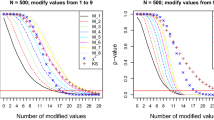Abstract
In this paper, a method for telecommunications fraud detection is proposed. The method is based on the user profiling by employing the Latent Dirichlet Allocation (LDA). The detection of fraudulent behavior is achieved with a threshold-type classification algorithm, allocating the telecommunication accounts into one of two classes: fraudulent account and non-fraudulent account. The accounts are classified with use of the Kullback-Leibler divergence (KL-divergence). Therefore, we also introduce four methods for approximating the KL-divergence between two LDAs. Finally, the results of experimental study on KL-divergence approximation and fraud detection in telecommunications are reported.
Access this chapter
Tax calculation will be finalised at checkout
Purchases are for personal use only
Preview
Unable to display preview. Download preview PDF.
Similar content being viewed by others
References
Taniguchi, M., Haft, M., Hollmen, J., Tresp, V.: Fraud Detection in Communications Networks Using Neural and Probabilistic Methods. In: IEEE International Conference on Acoustics Speech and Signal Processing ICASSP 1998, vol. 2, pp. 1241–1244. IEEE, Los Alamitos (1998)
Xing, D., Girolami, M.: Employing Latent Dirichlet Allocation for Fraud Detection in Telecommunications. Pattern Recognition Letters 28, 1727–1734 (2007)
Hilas, C.S., Mastorocostas, P.A.: An Application of Supervised and Unsupervised Learning Approaches to Telecommunications Fraud Detection. Knowledge-Based Systems 21, 721–726 (2008)
Hilas, C.S.: Designing an Expert System for Fraud Detection in Private Telecommunications Networks. Expert Systems with Applications 36, 11559–11569 (2009)
Farvaresh, H., Sepehri, M.M.: A Data Mining Framework for Detecting Subscription Fraud in Telecommunication. Engineering Applications of Artificial Intelligence (2010)
Gibbs, A.L., Su, F.E.: On Choosing and Bounding Probability Metrics. International Statistical Review 70(3), 419–435 (2002)
Olszewski, D., Kolodziej, M., Twardy, M.: A Probabilistic Component for K-Means Algorithm and its Application to Sound Recognition. Przeglad Elektrotechniczny 86(6), 185–190 (2010)
Blei, D.M., Ng, A.Y., Jordan, M.I.: Latent Dirichlet Allocation. Journal of Machine Learning Research 3, 993–1022 (2003)
Hershey, J.R., Olsen, P.A.: Approximating the Kullback Leibler Divergence Between Gaussian Mixture Models. In: IEEE International Conference on Acoustics Speech and Signal Processing ICASSP 2007, vol. 4(6), pp. 317–320 (2007)
Blei, D.M., Franks, K., Jordan, M.I., Mian, I.S.: Statistical Modeling of Biomedical Corpora: Mining the Caenorhabditis Genetic Center Bibliography for Genes Related to Life Span. BMC Bioinformatics 7(1) (May 2006)
Author information
Authors and Affiliations
Editor information
Editors and Affiliations
Rights and permissions
Copyright information
© 2011 Springer-Verlag Berlin Heidelberg
About this paper
Cite this paper
Olszewski, D. (2011). Fraud Detection in Telecommunications Using Kullback-Leibler Divergence and Latent Dirichlet Allocation. In: Dobnikar, A., Lotrič, U., Šter, B. (eds) Adaptive and Natural Computing Algorithms. ICANNGA 2011. Lecture Notes in Computer Science, vol 6594. Springer, Berlin, Heidelberg. https://doi.org/10.1007/978-3-642-20267-4_8
Download citation
DOI: https://doi.org/10.1007/978-3-642-20267-4_8
Publisher Name: Springer, Berlin, Heidelberg
Print ISBN: 978-3-642-20266-7
Online ISBN: 978-3-642-20267-4
eBook Packages: Computer ScienceComputer Science (R0)




